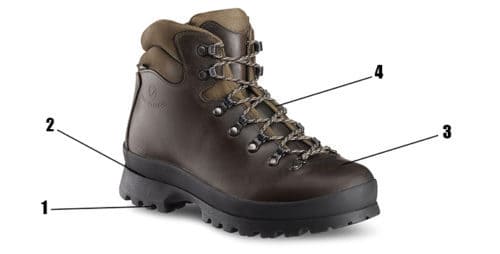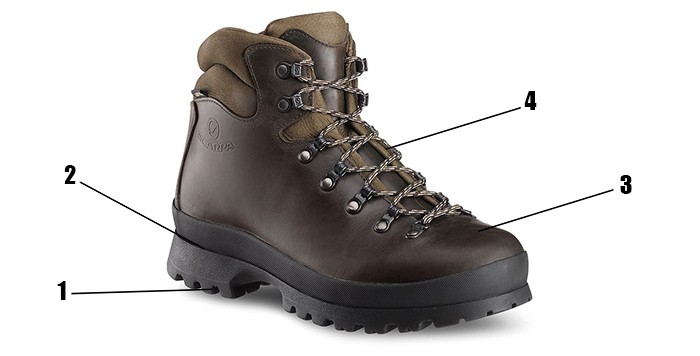An interesting infographic. Sometimes it is the basics we are a little unclear on…
The Ultimate Guide To Hiking Boots
Over the past decade, the variety of hiking boots and shoes has exploded, as designs become increasingly specialised. Here’s a guide that outlines your choices and will help you narrow down what you’ll need to find the perfect pair.
>>>>>>>>>>>>>>>>>>>>>>>>>>>>>>>>>>>>>>>>>>>>>>>>>>>>>>>>>>>>>>>>>>>>>>>>>>>>>>>>>
Anatomy of a Hiking Boot
Knowing the components of walking boots will help you choosing the perfect type of boot for whatever activity you decide to do.

- Outsole
- The outsole is the first thing everyone looks at when buying new walking boots.
- This is the strip of rubber or TPR along the bottom of the boot which features the tread.
- Tread patterns will vary depending on brand and boot, but all serve a purpose for a certain type of terrain.
- Chunkier patterns are better in mud, while shallow tread is better suited for a rockier path.
- When it comes to the outsole, the most popular and best known brand is ‘Vibram’.
- A Vibram sole has long been a sign of quality, but that isn’t to say standard soles won’t be suited to your activity.
- Midsole
- The midsole fits between the insole and the outsole.
- The job of a midsole is to act as a shock absorber, helping to cushion and protect your feet as you walk.
- Upper
- The upper is everything on the outside of the boot above the midsole.
- Uppers are often made from different materials such as sturdy and hard wearing leather, or synthetic fabrics which make for lightweight boots.
- Liner
- Some boots will feature a waterproof liner such as GORE-TEX, whilst this makes the boot waterproof and therefore ideal for wet weather walks, it can compromise breathability.
- For hot weather walking, it’s advised that you choose a boot with no liner to help your feet breathe.
- Toe Bumpers
- The purpose of toe bumpers is to protect your toes from knocks, which is particularly important on rocky terrains.
- Toe bumpers also protect the boot from damage so they last longer.
>>>>>>>>>>>>>>>>>>>>>>>>>>>>>>>>>>>>>>>>>>>>>>>>>>>>>>>>>>>>>>>>>>>>>>>>>>>>>
Best Walking Boots For Your Activity
The activity you have planned is one of the main factors of consideration when choosing walking boots.
Trail Running Shoes are best for:
- Trail running.
- Lightweight hiking and backpacking.
- Short day hikes on easy terrain.
Hiking Shoes are best for:
- Day hikes.
- Moderate backpacking.
- Long distance lightweight hiking and backpacking.
Hiking Boots are best for:
- Day hiking (added ankle support).
- Backpacking with loads heavier than 20-30 pounds
- Hiking in rough terrain or off-trail.
- Spring or summer hiking where snow will be encountered.
Mountaineering Boots are best for:
- High alpine travel.
- Winter hiking and climbing.
- General mountaineering.
Approach Shoes are best for:
- Climbing approaches.
- Easy to moderate climbing.
- Peak bagging on 4th and 5th class terrain.
>>>>>>>>>>>>>>>>>>>>>>>>>>>>>>>>>>>>>>>>>>>>>>>>>>>>>>>>>>>>>>>>>>>>>>>>>>>>>>>
You’ve Picked Out a Shoe— But How’s the Fit?
Because you’re going to be spending so much time in a hiking shoe or boot, fit is paramount. Here are some things to look for:
- Your feet tend to swell over the course of a day, try your shoes or boots on towards the end of the day or after some activity.
- If you wear orthotics, bring them along. They impact the fit of a boot.
- When you put them on, you should feel plenty of space in the toe box.
- You should not feel squashed on the sides of your forefoot but shouldn’t be too spacious.
- A good way to test the length of the shoe is to stand upright in unlaced shoes, and then slide your foot forward until it does touch the front.
- You should be able to comfortably slip your index finger in between your heel and the heel of the shoe.
- Once you have your shoe laced, the feel should be snug enough that, as you roll up onto your toe, you don’t feel your foot sliding forward to touch the front of the boot.
- It shouldn’t be so snug that it cuts off your circulation or causes hot spots.
- You should also not feel any heel lift or slip as you walk around.
- A loose fit on the heal increases the risk of painful blisters and could lead to injury on rough terrain if your boot goes one way and your foot the other.
>>>>>>>>>>>>>>>>>>>>>>>>>>>>>>>>>>>>>>>>>>>>>>>>>>>>>>>>>>>>>>>>>>>>>>>>>>>>>>>>>>
How To Care for Your Walking Boots
Your walking boots will last longer if you take care of them. Caring for your boots is simple, and here are a few things to remember:
- Rapid drying, heater drying and not nourishing the leather of the boots can all lead to a boot cracking and eventually splitting.
- Clean your boots, thoroughly removing all mud and debris.
- Boots need nourishing when they look dry.
- Reproof little and often.
- Do not dry boots in a hot room or near a heater, this can cause leather and material to shrink and crack.
- If stuffing with paper to help dry, try not to overstuff and misshape the boot.
>>>>>>>>>>>>>>>>>>>>>>>>>>>>>>>>>>>>>>>>>>>>>>>>>>>>>>>>>>>>>>>>>>>>>>>>>>>>>>>>>>
References
http://www.gooutdoors.co.uk/expert-advice/hill-walking-boots
http://www.outdoorgearlab.com/Hiking-Shoes-Womens-Reviews/Buying-Advice
http://www.mountainwarehouse.com/expert-advice/walking-boots-guide
http://www.backcountry.com/explore/how-to-choose-the-right-hiking-shoes-backpacking-boots
Coutesy of: https://www.walshbrothersshoes.ie/blogs/news/147312007-the-ultimate-guide-to-hiking-boots
See:
http://www.gooutdoors.co.uk/expert-advice/hill-walking-boots
https://www.fortheloveofoutdoors.com/guide-hiking-boots/
I must say I am not fond of Vibram soles. The only two pairs of shoes I have owned with this type of sole would not grip in the wet (particularly rocks, leaves, logs, twigs) so that I quickly ended up crashing down onto the back of my neck (which is not pleasant). It may be that there are Vibram soles which are not like this. I also do not favor waterproof shoes. You are going to get wet feet. Don’t be a sissy. And don’t muck around trying not to get wet feet. Shoes which are not waterproof are lighter – and dry quicker! Carry a pair of ultralight camp shoes (such as these http://www.theultralighthiker.com/toughened-foam-flip-flop/ or these: http://www.theultralighthiker.com/no-sew-sandals/) so you have something comfy to put on at the end of the day.
See also:
http://www.theultralighthiker.com/keen-shoes/
http://www.theultralighthiker.com/tight-shoes/
http://www.theultralighthiker.com/4wd-boots/
http://www.theultralighthiker.com/boot-chains/
http://www.theultralighthiker.com/foot-care/
http://www.theultralighthiker.com/shoe-laces/
http://www.theultralighthiker.com/survival-laces/

